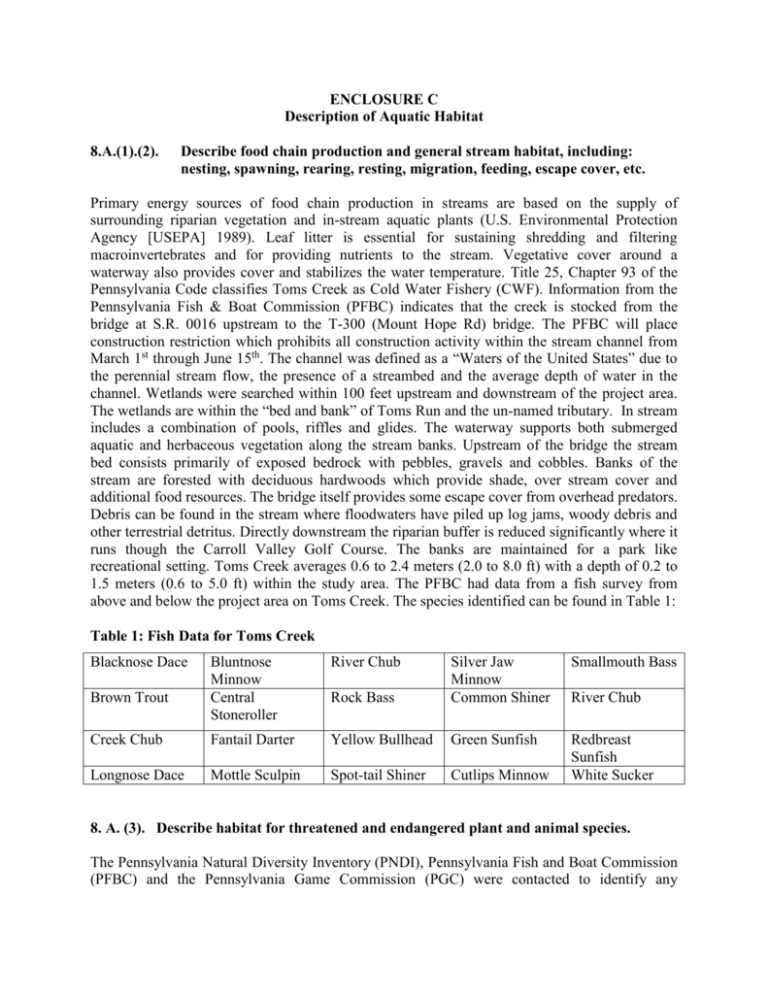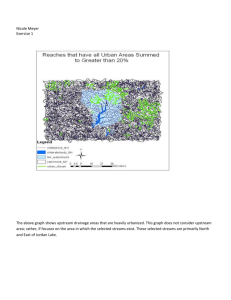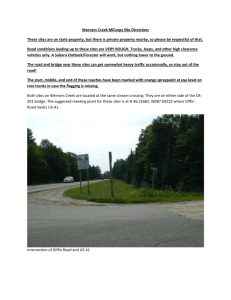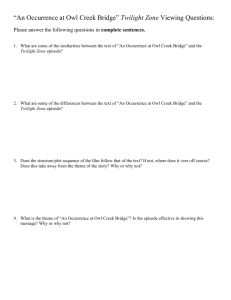ENCLOSURE C
advertisement

ENCLOSURE C Description of Aquatic Habitat 8.A.(1).(2). Describe food chain production and general stream habitat, including: nesting, spawning, rearing, resting, migration, feeding, escape cover, etc. Primary energy sources of food chain production in streams are based on the supply of surrounding riparian vegetation and in-stream aquatic plants (U.S. Environmental Protection Agency [USEPA] 1989). Leaf litter is essential for sustaining shredding and filtering macroinvertebrates and for providing nutrients to the stream. Vegetative cover around a waterway also provides cover and stabilizes the water temperature. Title 25, Chapter 93 of the Pennsylvania Code classifies Toms Creek as Cold Water Fishery (CWF). Information from the Pennsylvania Fish & Boat Commission (PFBC) indicates that the creek is stocked from the bridge at S.R. 0016 upstream to the T-300 (Mount Hope Rd) bridge. The PFBC will place construction restriction which prohibits all construction activity within the stream channel from March 1st through June 15th. The channel was defined as a “Waters of the United States” due to the perennial stream flow, the presence of a streambed and the average depth of water in the channel. Wetlands were searched within 100 feet upstream and downstream of the project area. The wetlands are within the “bed and bank” of Toms Run and the un-named tributary. In stream includes a combination of pools, riffles and glides. The waterway supports both submerged aquatic and herbaceous vegetation along the stream banks. Upstream of the bridge the stream bed consists primarily of exposed bedrock with pebbles, gravels and cobbles. Banks of the stream are forested with deciduous hardwoods which provide shade, over stream cover and additional food resources. The bridge itself provides some escape cover from overhead predators. Debris can be found in the stream where floodwaters have piled up log jams, woody debris and other terrestrial detritus. Directly downstream the riparian buffer is reduced significantly where it runs though the Carroll Valley Golf Course. The banks are maintained for a park like recreational setting. Toms Creek averages 0.6 to 2.4 meters (2.0 to 8.0 ft) with a depth of 0.2 to 1.5 meters (0.6 to 5.0 ft) within the study area. The PFBC had data from a fish survey from above and below the project area on Toms Creek. The species identified can be found in Table 1: Table 1: Fish Data for Toms Creek Blacknose Dace Bluntnose Minnow Central Stoneroller River Chub Creek Chub Longnose Dace Brown Trout Smallmouth Bass Rock Bass Silver Jaw Minnow Common Shiner Fantail Darter Yellow Bullhead Green Sunfish Mottle Sculpin Spot-tail Shiner Cutlips Minnow Redbreast Sunfish White Sucker River Chub 8. A. (3). Describe habitat for threatened and endangered plant and animal species. The Pennsylvania Natural Diversity Inventory (PNDI), Pennsylvania Fish and Boat Commission (PFBC) and the Pennsylvania Game Commission (PGC) were contacted to identify any occurrences of threatened or endangered species within the study area. Their review indicated no state listed endangered or threatened species are known to occur in the project area. The U.S. Fish and Wildlife Service (USFWS) indicated the project area was within the known range of the bog turtle (Clemmys muhlenbergii), a federally listed species. A Phase I Bog Turtle Habitat survey was conducted along with the wetland delineation and identification. Bog turtles are known to inhabit shallow, spring-fed seeps, swamps and marshy meadows with soft, muddy bottoms. The report documented that there were no wetlands in the project area and no bog turtle habitat was found. The report was submitted to USFWS, PFBC, PADEP, and USACE for concurrence. The USFWS and PFBC have reviewed the report and concur with the finding of no impacts to bog turtles. 8.A.(4). Describe environmental study areas in the form of a) sanctuaries and b) refuges. There are no (a) wildlife sanctuaries or (b) refuges within the limits of the study area. 8.A.(5). Provide a description of the in-stream macroinvertebrate community if the project proposes a stream relocation, a stream enclosure, or dredging. No realignment of the stream channel will take place, no stream enclosures or dredging is proposed. Temporary in-stream work will be necessary to remove the existing pier and construct the new bridge abutments. A detailed observation of the in-stream macroinvertebrate community was not done; however, correspondence with the Pennsylvania Fish and Boat Commission Fisheries Management Department provided data on two survey sites; one upstream of the project area at the SR 3021 bridge and one further downstream of the project area at the SR 0016 bridge crossing. A summary of the data identified a good diversity of species of macroinvertebrates such as stonefly, caddisfly, mayfly, water penny, riffle beetle, black fly, water beetle and dragonfly. The macroinvertebrates identified are in Table 2. The proposed project will not have significant detrimental effects on the stream habitat. The description of project impacts are described in Section D (Project Impacts 9B (1). Table 2. Invertebrate Data for Toms Creek Ephemeroptera Baetidae Ephemerellidae Heptageniidae Plecoptera Perlodidae Coleoptera Dytiscidae Odonata Aeshnidae Diptera Chironomidae Tipulidae Hemiptera Gerridae Veliidae Trichoptera Glossosomatidae Hydropsychidae Philpotamidae Polycentropodidae Decapoda Cambaridae Amphipoda Gammaridae 8.B. Describe water quantity and stream flow, including: natural drainage patterns, flushing characteristics, groundwater discharge for baseflow, and natural recharge areas for ground and surface waters. Toms Creek is a tributary to the Monocacy River, part of the larger Potomac River Basin. The Potomac River flows south east and empties into the Chesapeake Bay. PFBC water quality tests above the project site (360 meters down steam from SR 3021) bridge indicated these values: TEMP (C) 18 D.O. ml/g 9.5 ALK. Mg/1 18 Hard. 18 pH 7.1 PFBC water quality data below the project area at PA Route 0016 bridge indicated these values: TEMP (c) 19 D.O. (ml/g) 9.3 ALK. Mg/l 42 Hard. 42 pH 7.2 Water quality of Toms Creek meets the criteria and is classified as “approved trout waters”. which requires the water to have maintenance or propagation, or both, of fish species including the family salmonidae and additional flora and fauna which are indigenous to a cold water habitat. An unnamed tributary parallels SR 0116 and enters Toms Creek from the west just above the bridge. This unnamed tributary receives its water from upslope drainage and several springs and seeps. These sources are out of the project area and will not be impacted. No other groundwater sources were identified in the project area. Impacts are discussed in 9 B (2). 8.C. Describe water quality, including: preventing pollution, sedimentation control and patterns, salinity distribution, and natural water filtration. Pennsylvania Code, Title 25, Chapter 93: Water Quality Standards classifies Toms Creek as a CWF. It is a perennial waterway, and its average water depth within the project area ranges from 0.2 to 1.5 meters (0.7 to 5.0 feet). The water quality of Toms Creek is of good quality. The primary water quality issues are non-point source pollution from storm water runoff from the surrounding residential lots, park property and golf course adjacent to the waterway. Adjacent greenways including the park property and in-stream vegetation help to prevent pollution and control sedimentation. The salinity distribution of this stream is normal for regional freshwater streams. A man made lake part of the Carroll Valley Municipal Park is located approximately 200 yards upstream of the bridge. Its function is primarily recreational use. The outflow from the lake enters Toms Creek from a concrete chute from the high water/overflow water dam. Warm surface water discharges from this lake would be considered a source of thermal pollution. 8.D. Describe recreation, including: game species, non-game species, fishing, hiking, observation of plant and wildlife, other. Toms Creek is stocked with adult brook and brown trout by the Pennsylvania Fish and Boat Commission from the S.R. 0016 bridge upstream to T-300 bridge. A cooperative nursery stocks adult rainbow trout. Upstream of the bridge the Carroll Valley Municipal Park property offers recreation to the public in many forms which includes hiking, fishing, and the observation of plants and wildlife. Downstream of the project area, the creek flows through the privately owned public Carroll Valley Golf Course. The golf course offers recreational opportunities. This limits the fishing and hiking opportunities. The proposed impacts are described in Section D 9.B. (4). 8.E. Describe upstream and downstream property. The project area is located in a mixed rural setting comprised of park property, residential, and recreational uses. Upstream of the project area on the east bank, the creek borders the Carroll Valley Municipal Park. The west bank backs up to several private property lots, located on a steep deciduous forested hillside. The upstream east bank land use borders the Carroll Valley Park property. A man made lake belonging to the Carroll Valley Municipal Park is approximately 200 yards upstream of the bridge. Directly downstream the creek runs through the Carroll Valley Golf Course owned by the Carroll Valley Resort Company. A narrow riparian area remains forested. The majority of the creek banks are kept maintained for the golf course. Within the right-of-way the roadside contains a mixture of trees, shrubs and herbaceous plants. Impacts are described in the Section D 9.B (5). 8.F. Describe other environmental factors determined by site investigation. A Phase I ESA was conducted for this project site. There was no indication that the project area or adjacent properties contain hazardous material. A recommendation of No Further Action (NFA) was given for the project site. REFERENCES: Pennsylvania Fish and Boat Commission, Fisheries Management Division Stream Data Site taken 6/2/1980. John Fredrick, Fisheries Management Area 7. USEPA 1989






